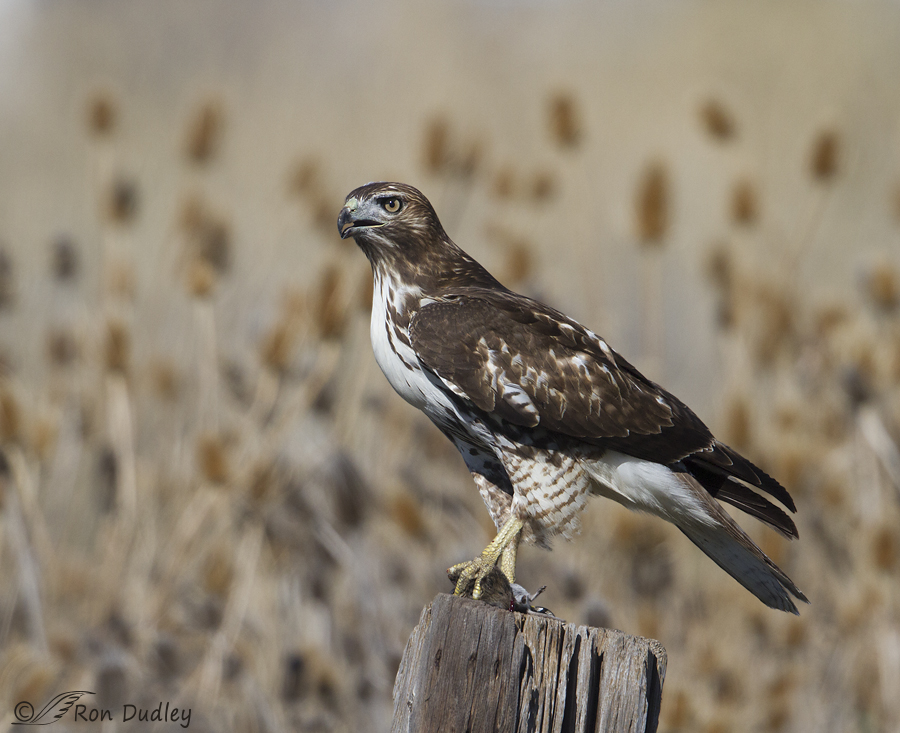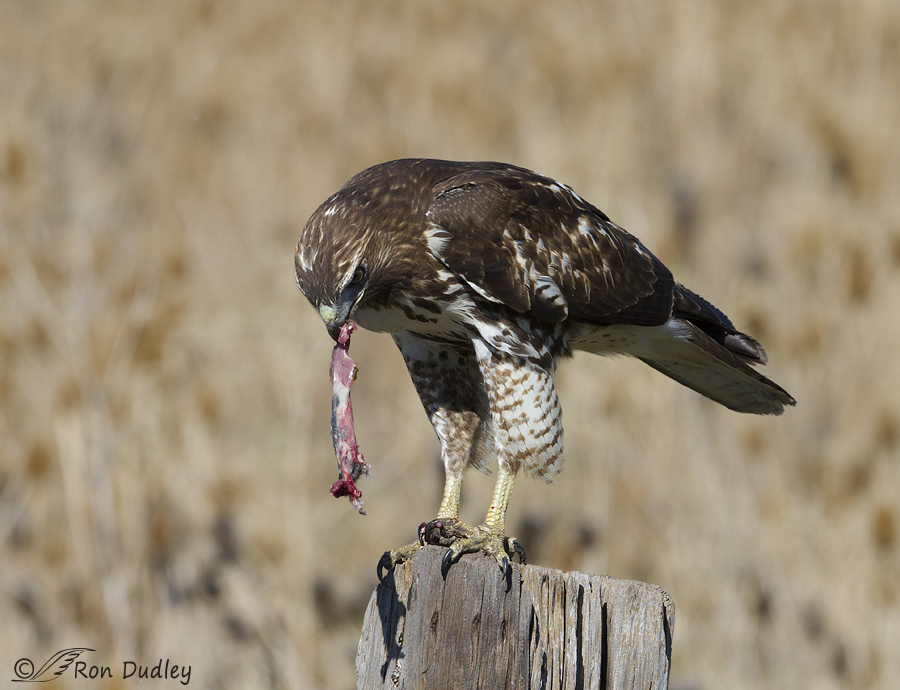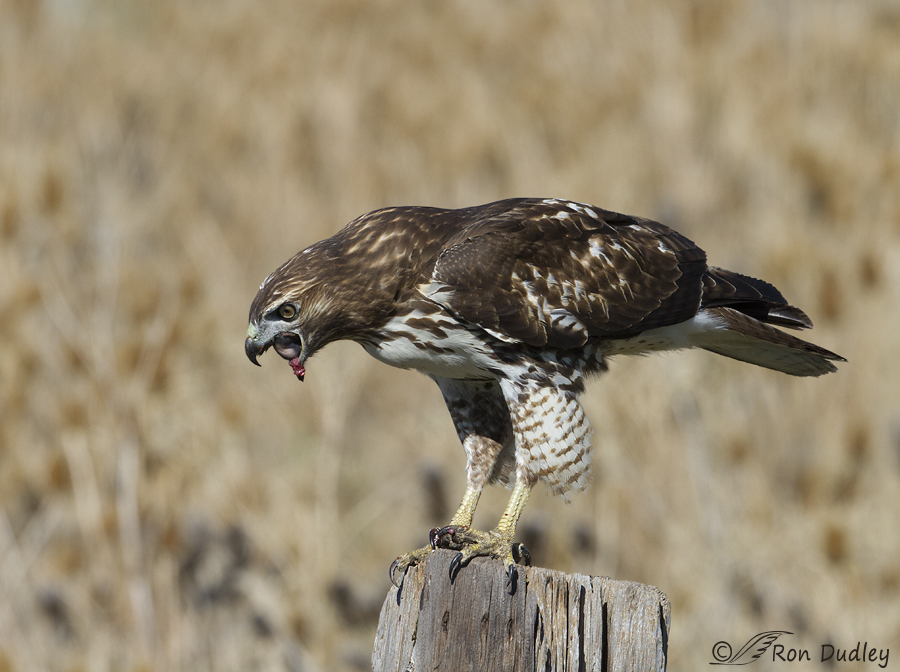Migrating hawks have become more frequent in the valley of the Great Salt Lake and I’m delighted to see them again.
- Note: Fair warning – the second photo in this sequence is slightly graphic so sensitive folks may want to avoid scrolling further than the first image.

1/3200, f/6.3, ISO 500, Canon 7D, Canon EF500mm f/4L IS II USM +1.4 tc, not baited, set up or called in
I photographed this juvenile Red-tailed Hawk yesterday morning near Farmington Bay as it prepared to eat a vole it had just caught. Its crop already appears to be bulging and it hasn’t yet started feeding on this rodent so hunting is apparently good. The dark seed heads in the background may be distracting for some but I like the haughty, almost cocky pose from the hawk.
Usually when I see red-tails feeding on voles they tear them into a few relatively large chunks and swallow each piece individually. This bird chose a different tack.

1/2500, f/7.1, ISO 500, Canon 7D, Canon EF500mm f/4L IS II USM, not baited, set up or called in
It opened the vole, consumed a few tiny bits and then, like I pull a sock off of my foot, it turned the rodent inside-out by pulling it between its beak and one of its feet. It was a pretty nifty trick to watch and photograph. I’ll spare you more gory images of the process but as soon as it was accomplished…

1/2500, f/7.1, ISO 500, Canon 7D, Canon EF500mm f/4L IS II USM, not baited, set up or called in
it swallowed the carcass relatively whole, though certainly transformed. The hawk then briefly cleaned its feet, roused and took off.
I’m already looking forward to a good “raptor winter” with a variety of hawk, falcon and eagle species. Partly for my sake, but mostly for theirs, I hope I’m not disappointed.
Ron


Sensational shots Ron! Thanks for sharing!
Charlotte
What an amazing thing to be able to see and photograph! Yes, that second photo is graphic, but at the same time it’s educational and it shows the bird’s incredible skills – not violence – so it’s not as hard to look at as one might expect. I love the things I learn from reading your blog.
Ron, from one of your pics it looks like some of the guts slid off. The kestrel and broad winged educational birds I feed always leave the guts for me to clean up. Eat everything else especially the heads. They get 20-30 gram mice.
Thanks for the photos. Especially the last one with it’s mouth open.
They very well could have, Diana. I’ve photographed and posted about raptors rejecting the intestinal tract several times and wondered if the hawk had eviscerated the vole before I was able to get my lens on the bird.
Efficient and tidy(ish). And fascinating. I do like the ‘vole slider’ description – but am grateful that the description is as close as I will get.
I like that “vole slider” phrase too, Elephant’s Child – it always comes to mind when I see one “go down” quickly.
Like Mikal, we do have birds that routinely turn their food inside-out; most often rats (nothing like a skinned rat tail!), which, I assume, have pretty thick skin. Can’t say I’ve seen it much with vole-sized food, though! And, for enrichment, we sometimes give rabbit skin/fur – which they love and will even swallow, despite the lack of anything resembling meat left attached to it.
Thanks for the knowledgeable background info, Louise – much appreciated.
I once took care of a Swainson’s Hawk that habitually turned large rats inside out, consumed the filling but discarded the tough crust. A very tidy and efficient system for her.
Thank you for the beautiful start to my day, once again!
Interesting, Mikal. I’m guessing then that sometimes individual birds develop unique feeding habits that aren’t necessarily the same as those of others of the same species…
Interesting images…as usual. Like Jorge’s cooments (also lije Jorge!)…
Thank you, Patty.
In spite of being gory it is always interesting to know how raptors develop their feeding technics. This one reminds me that in Asia when someone wants to get rid of a snake skin he makes a deep cut around the snake’s neck put the head under the foot, grab the tail and pull. The skin comes out in one piece. Not nice to see but very effective. Maybe this juvenile Hawk had some relatives there…
Thanks for sharing.
“it is always interesting to know how raptors develop their feeding technics.”
I agree, Jorge. Seeing this made me wonder if this is a deliberate technique learned and practiced repeatedly by this individual bird or if what happened was just accidental to some degree.
I guess we will only know if in the future you’ll find the same bird or other Hawks doing it.
I’ll be looking for just that, Jorge.
Fascinating! And if that information is encoded into genetic memory, how? It would certainly make the vole slide down easier, I suspect. Must say it makes me all the more grateful for eating apples instead of fresh kill.
Ha, “vole sliders” seem to work for them just fine, Alison. Like you I prefer a slightly different fare…